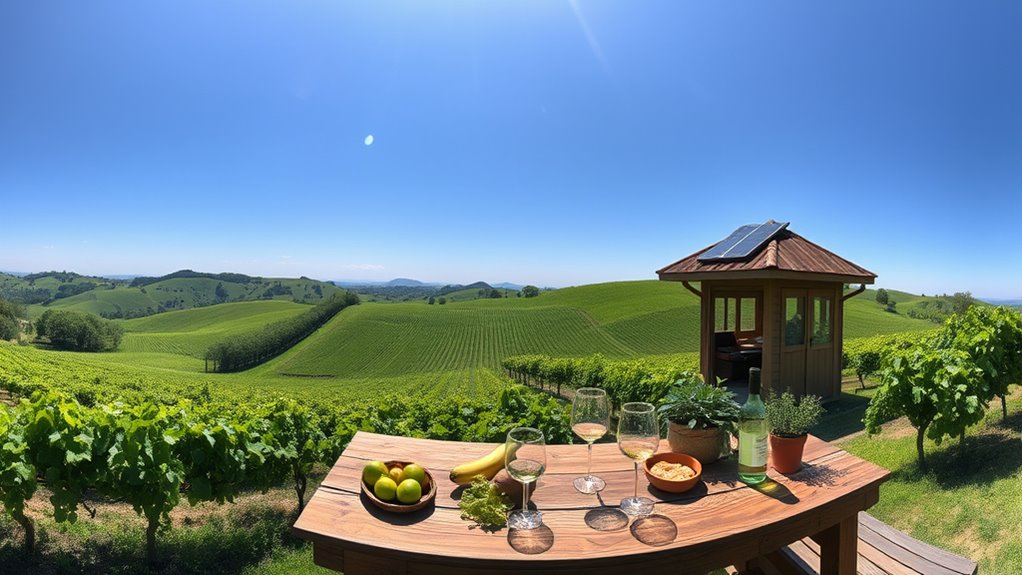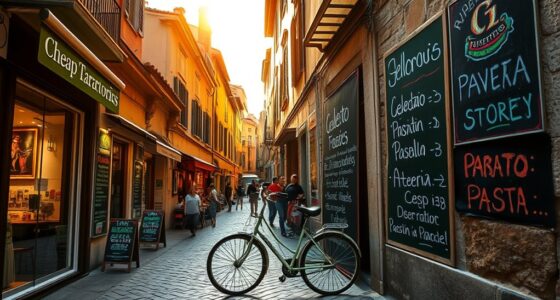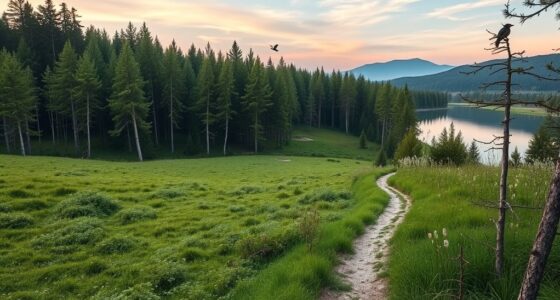Sustainable wine tourism in Valpolicella lets you enjoy the region’s stunning landscapes while supporting eco-friendly practices. Wineries in the area use renewable energy, organic farming, and water conservation to protect the environment. You can explore responsible tourism options, participate in eco-tours, and experience local culture and craftsmanship. By choosing sustainable experiences, you help preserve Valpolicella’s beauty for future visitors. To learn more about how this charming region blends tradition with sustainability, keep exploring.
Key Takeaways
- Wineries in Valpolicella integrate eco-friendly practices like renewable energy, organic farming, and water conservation to promote sustainability.
- Preservation of the natural landscape and traditional vineyard architecture enhances authentic eco-conscious wine tourism experiences.
- Community engagement and support for local artisans foster regional pride and sustainable tourism development.
- Responsible tourism initiatives include eco-tours, educational programs, and eco-friendly accommodations emphasizing environmental awareness.
- Climate adaptation strategies ensure vineyard resilience and longevity amid changing weather patterns, supporting sustainable growth.
The Charm of Valpolicella’s Natural Landscape
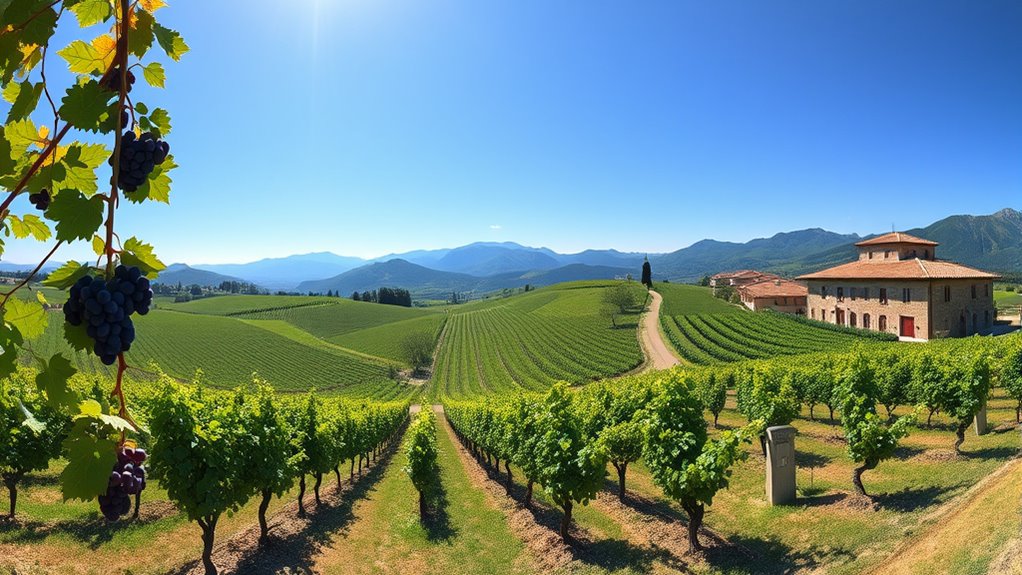
Nestled in the rolling hills of northern Italy, Valpolicella’s natural landscape captivates visitors with its lush vineyards, gentle slopes, and scenic vistas. The region’s vineyard architecture seamlessly blends tradition with design, showcasing charming stone-walled cellars and trellised rows that echo centuries of winemaking heritage. As you explore, you’ll notice how landscape preservation efforts maintain the area’s pristine beauty, ensuring that the natural environment remains intact amidst ongoing cultivation. This harmony between human craftsmanship and nature enhances the region’s allure, inviting you to appreciate not just the wine but the carefully preserved scenery that frames every vineyard. Valpolicella’s landscape isn’t just a backdrop; it’s a essential part of the experience, reflecting a deep respect for nature’s timeless beauty. Additionally, understanding landscape preservation techniques helps maintain the region’s unique ecological and aesthetic value, which is vital for sustainable wine tourism and ongoing cultural traditions. Implementing these practices also supports the region’s commitment to environmental sustainability, ensuring future generations can enjoy its natural splendor, while fostering community engagement in conservation efforts.
Eco-Friendly Practices in Local Wineries
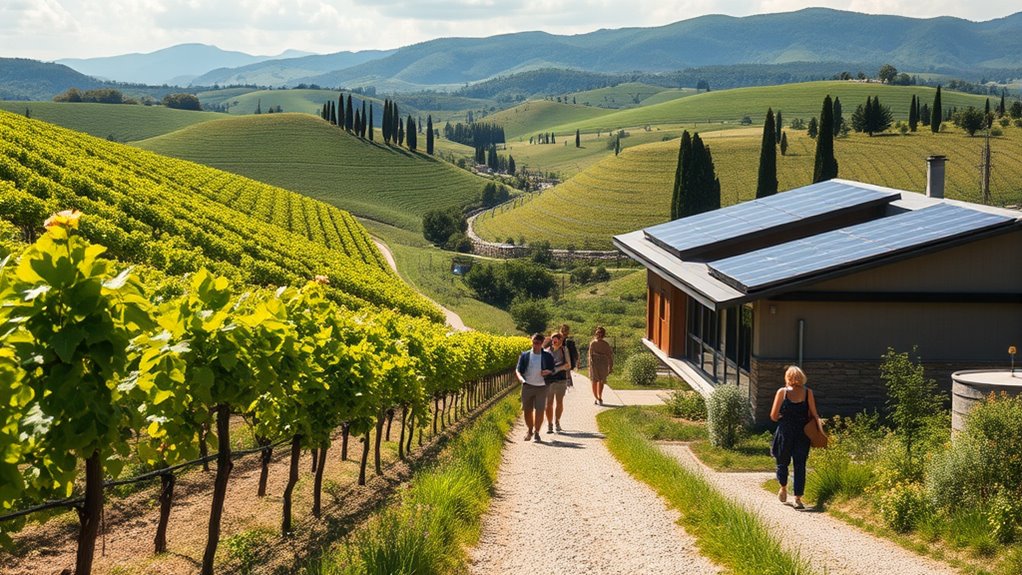
Many wineries in Valpolicella actively embrace eco-friendly practices to protect the region’s delicate environment. They utilize renewable energy sources like solar energy and wind power to reduce their carbon footprint. Here are some ways they do this:
Valpolicella wineries adopt eco-friendly practices, harnessing solar, wind, and efficient resources to protect the environment.
- Installing solar panels to harness sunlight and generate clean electricity for their operations.
- Using wind turbines to supplement energy needs, especially in areas with consistent breezes.
- Implementing energy-efficient equipment to minimize power consumption.
- Recycling water and organic waste to lower environmental impact.
- Proper soil management and pest control practices help maintain vineyard health and sustainability. Additionally, understanding trust issues and fostering honest communication can support community efforts toward sustainable practices. Employing environmental monitoring tools allows wineries to track their ecological impact and make data-driven improvements. Furthermore, participating in certification programs that promote sustainable agriculture standards and practices demonstrates their commitment to environmental stewardship.
Organic and Biodynamic Vineyards

When you visit organic and biodynamic vineyards, you’ll notice how they prioritize soil health, leading to healthier vines and better grapes. Natural pest management reduces chemical use, creating a more sustainable environment. This approach often results in wines with enhanced flavor and character you can truly appreciate. Many vineyards also select dog names that reflect their commitment to tradition and quality, adding a personal touch to the wine experience. Additionally, these sustainable practices help preserve the soil ecosystem, which is fundamental to maintaining home furnishings and the land’s long-term vitality for future generations. Implementing sustainable farming techniques can further improve vineyard management and efficiency in sustainable practices.
Soil Health Benefits
Organic and biodynamic vineyards in Valpolicella actively improve soil health by emphasizing natural practices that enrich the land. These methods support a vibrant soil microbiome, essential for healthy vine growth. By promoting biodiversity, they enhance nutrient cycling, ensuring crucial minerals return to the soil naturally. Here’s how these vineyards benefit soil health:
- They foster diverse microorganisms that strengthen soil structure.
- They reduce chemical inputs, allowing natural nutrient processes to thrive.
- They build organic matter, improving water retention and aeration.
- They support balanced nutrient cycling, minimizing erosion and depletion.
- Innovative techniques encourage farmers to experiment with innovative techniques that further enhance soil vitality.
As a result, healthier soil leads to more resilient vines, better grape quality, and a sustainable ecosystem that sustains Valpolicella’s wine tradition. This approach creates a cycle of land vitality and ecological harmony.
Natural Pest Management
Natural pest management in Valpolicella’s organic and biodynamic vineyards relies on ecological techniques that minimize chemical use and foster a balanced ecosystem. You can reduce pest pressure by planting pest resistant grape varieties, which naturally withstand common pests without chemicals. Additionally, creating beneficial insect habitats encourages populations of predatory insects that control pests naturally. These habitats include flowering cover crops, hedgerows, and insect hotels, providing shelter and food sources for helpful insects like ladybugs and parasitic wasps. By integrating these strategies, you support biodiversity and promote healthy vine growth. Using modern monitoring tools can help vineyard managers detect pest issues early and apply targeted interventions, further reducing chemical reliance. This approach not only protects the environment but also aligns with sustainable wine tourism, attracting visitors interested in eco-friendly practices. Ultimately, natural pest management helps maintain the authenticity and ecological integrity of Valpolicella’s vineyards. Incorporating biological control methods can further enhance pest regulation by naturally balancing pest populations without synthetic inputs. Additionally, implementing integrated pest management practices ensures a comprehensive approach to pest control, combining biological, cultural, and mechanical methods for sustainable vineyard health. To further strengthen these efforts, fostering farmer education about ecological techniques can lead to more effective and widespread adoption of sustainable practices. Engaging in educational initiatives can also raise awareness among visitors about the benefits of eco-friendly vineyard practices, strengthening the connection between sustainability and wine tourism.
Wine Quality Enhancement
Implementing organic and biodynamic practices in Valpolicella’s vineyards directly enhances wine quality by emphasizing soil health and vine vigor. These methods promote healthier vines, which improve fruit expression and consistency. Better soil management leads to more balanced nutrients, supporting optimal wine aging potential. Consider these key aspects:
- Focus on vineyard design to maximize sun exposure and airflow, reducing disease risk.
- Use organic composts and biodynamic preparations to strengthen vine resilience.
- Prioritize soil vitality to influence flavor complexity and structure.
- Monitor vine vigor closely, adjusting practices to maintain balance for superior aging capacity. Additionally, integrating ethical hacking techniques can help vineyard managers safeguard their data and operational systems from cyber threats, ensuring smooth and secure winemaking processes.
Sustainable Vineyard Management Techniques
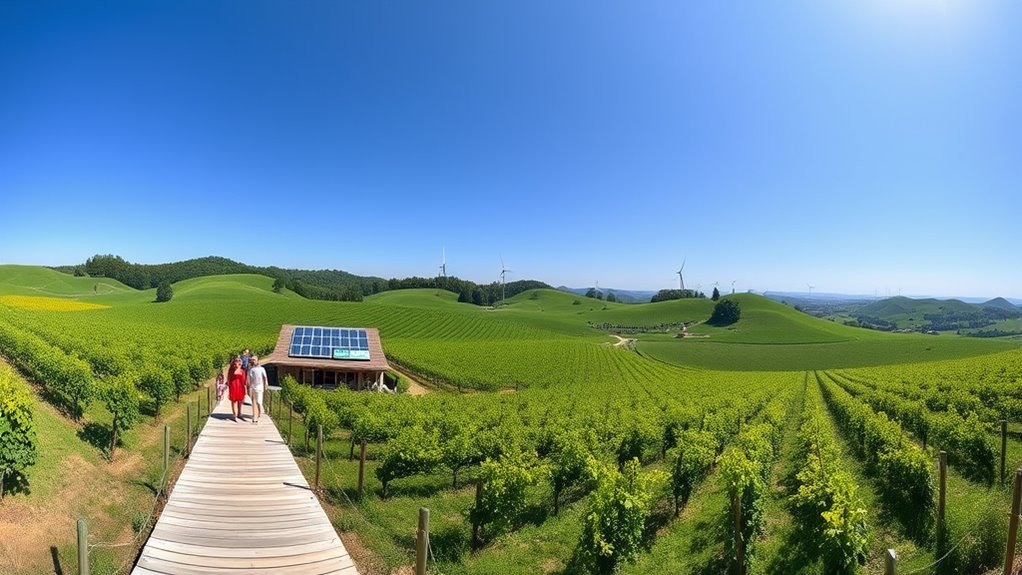
You can implement organic pest control to protect your vineyards without harmful chemicals, ensuring healthier grapes and a healthier environment. Water conservation strategies help you use resources efficiently, reducing waste and costs. Promoting biodiversity on your estate encourages natural pest management and creates a resilient ecosystem around your vines.
Organic Pest Control
Have you ever wondered how vineyards can protect their crops without relying on synthetic chemicals? Organic pest control offers effective solutions that prioritize sustainability. Here’s how you can implement organic methods for pest control:
- Use beneficial insects, like ladybugs, to naturally reduce pest populations.
- Apply organic sprays such as neem oil or insecticidal soaps to target specific pests.
- Rotate crops and plant pest-repelling herbs to deter unwanted insects.
- Maintain healthy soil with compost and organic matter to boost vine resilience.
These techniques help minimize chemical use, support biodiversity, and promote a healthier vineyard environment. Organic pest control not only safeguards your crops but also aligns with sustainable wine tourism principles, offering visitors a glimpse into eco-friendly vineyard practices.
Water Conservation Strategies
Effective water management is essential for sustainable vineyard operations, especially in regions prone to drought or irregular rainfall. You can improve water conservation by implementing rainwater harvesting systems that collect and store rainfall for later use. This reduces reliance on groundwater and taps into a renewable resource. Additionally, focusing on irrigation efficiency helps optimize water use; using drip irrigation or soil moisture sensors ensures water is delivered directly to the vine roots, minimizing waste. Regularly monitoring soil moisture levels allows you to adjust watering schedules, preventing over-irrigation. These strategies not only conserve water but also promote healthier vines and better grape quality. By adopting rainwater harvesting and enhancing irrigation efficiency, you contribute to the long-term sustainability of your vineyard and the environment.
Biodiversity Promotion
Promoting biodiversity within your vineyard is a vital strategy for sustainable management, as it enhances ecosystem resilience and supports natural pest control. To do this effectively:
- Create wildlife corridors that connect different habitat patches, allowing animals to move safely and maintain healthy populations.
- Preserve native plants around your vineyard, providing food and shelter for local wildlife.
- Incorporate native plant species into cover crops, which can improve soil health and attract beneficial insects.
- Limit chemical use to protect these habitats and encourage biodiversity.
Responsible Tourism and Visitor Engagement

Responsible tourism in Valpolicella means engaging visitors in ways that respect the environment, local culture, and community. You play a key role by seeking out wineries with ethical certifications and participating in visitor education programs. These initiatives promote awareness about sustainable practices and help preserve the region’s heritage. To enhance your experience, consider the following:
| Practice | Benefit | Example |
|---|---|---|
| Supporting ethical certifications | Ensures responsible operations | Choosing certified wineries |
| Participating in visitor education | Increases environmental awareness | Guided eco-tours |
| Respecting local customs | Preserves cultural integrity | Learning regional traditions |
| Reducing waste | Minimizes environmental impact | Using recyclable materials |
Green Initiatives Behind the Scenes

Behind the scenes of Valpolicella’s renowned wineries, green initiatives are quietly making a significant impact. You’ll notice wineries focusing on reducing their carbon footprint through various strategies.
- They switch to renewable energy sources, like solar and wind power, decreasing reliance on fossil fuels.
- Waste management systems are optimized to recycle and minimize waste.
- Water conservation measures are implemented to cut down on usage and runoff.
- Sustainable packaging options are increasingly adopted, reducing plastic and non-recyclables.
These efforts help wineries operate more sustainably while preserving the region’s natural beauty. By focusing on renewable energy and cutting their carbon footprint, they set a powerful example of environmental responsibility behind the scenes, ensuring that Valpolicella’s wine heritage remains vibrant and eco-friendly for generations to come.
Community Involvement and Local Partnerships

Community involvement and local partnerships are the backbone of Valpolicella’s thriving wine industry, fostering strong connections between wineries and their surrounding communities. By engaging with the local community, wineries build trust and shared goals, ensuring sustainable growth. Partnership collaborations enable resource sharing, joint marketing efforts, and community-driven initiatives that benefit everyone. You’ll find local artisans, farmers, and businesses working closely with wineries to support eco-friendly practices and cultural preservation. These relationships create a sense of ownership and pride, making visitors feel more connected to the region’s heritage. When you participate in community-led events or support local businesses, you help strengthen these bonds, ensuring that Valpolicella’s wine tourism remains sustainable, authentic, and beneficial for both residents and visitors alike.
Exploring the Region: Eco-Conscious Travel Options

As you explore Valpolicella’s picturesque landscapes, opting for eco-conscious travel options allows you to enjoy the region’s beauty while minimizing your environmental impact. You can:
- Choose transportation methods like electric bikes or shared shuttles that meet eco label standards.
- Stay at accommodations with organic certification and eco-friendly practices.
- Use guided tours focused on sustainable practices, supporting local initiatives.
- Support wineries that pursue organic certification and adhere to eco label standards, ensuring environmentally responsible production.
Future Perspectives for Sustainable Wine Tourism
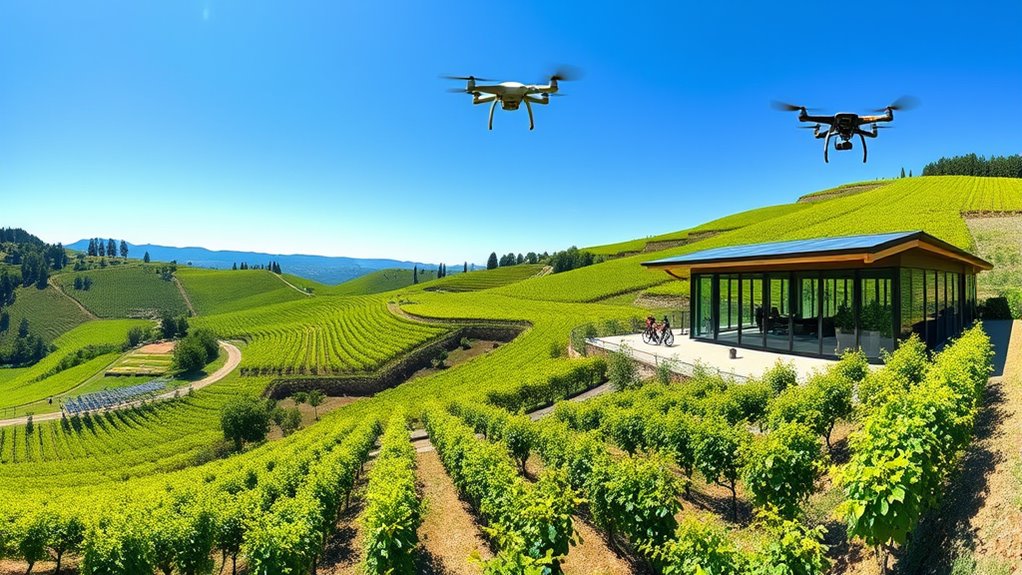
Looking ahead, the future of sustainable wine tourism in Valpolicella hinges on innovative practices and increased collaboration among producers, visitors, and local authorities. Embracing innovative marketing strategies will attract eco-conscious tourists and promote responsible visits. Climate adaptation becomes essential as changing weather patterns impact vineyards; implementing resilient practices ensures longevity. Visualize the region through this imagery:
| Vineyards adapting | Eco-friendly accommodations | Visitors engaging |
|---|---|---|
| Solar-powered systems | Organic farming methods | Participating in tastings |
| Water conservation | Green transportation options | Learning about sustainability |
| Weather-resistant grapes | Local eco-initiatives | Supporting local artisans |
| Adaptive pruning | Sustainable packaging | Sharing eco-friendly experiences |
Frequently Asked Questions
How Do Local Wineries Measure Their Sustainability Impact?
You can measure a winery’s sustainability impact by tracking its carbon footprint, which shows how much greenhouse gas it emits. Additionally, they assess biodiversity preservation efforts, ensuring local ecosystems thrive alongside vineyard activities. Wineries might also monitor water and energy use, waste management, and community engagement. These metrics help you understand how well they balance production with environmental responsibility, promoting sustainable practices that protect the land and support local biodiversity.
Are There Specific Certifications for Eco-Friendly Wineries in Valpolicella?
Imagine strolling through lush vineyards where the sun filters through organic leaves. You’ll find wineries in Valpolicella with eco label standards and organic certifications, proving their commitment to sustainability. These certifications, like organic labels, guarantee eco-friendly farming practices. Wineries proudly display these marks, showing visitors their dedication to protecting the environment while offering authentic, eco-conscious wines. So, yes, specific eco labels and organic certifications help identify eco-friendly wineries in Valpolicella.
What Training Do Staff Receive in Sustainable Wine Tourism Practices?
You’re likely curious about the staff education and customer engagement in sustainable wine tourism practices. Typically, staff receive specialized training focused on eco-friendly procedures, responsible hospitality, and engaging visitors with the winery’s sustainability efforts. This education helps you better inform and involve customers, fostering a memorable experience. Well-trained staff can effectively communicate sustainability initiatives, enhancing guest satisfaction while promoting environmental consciousness, which benefits both the winery’s reputation and the local community.
How Does Sustainable Tourism Benefit Local Communities Economically?
Did you know that communities embracing sustainable tourism see a 20% boost in local income? When you promote sustainable practices, you help diversify the economy, reducing reliance on a single industry. This approach also supports cultural preservation, ensuring traditions and heritage thrive. As a result, local communities benefit economically through job creation, increased sales, and a stronger, more resilient economy that sustains both people and culture for future generations.
What Challenges Do Wineries Face When Implementing Eco-Friendly Initiatives?
You might face challenges when implementing eco-friendly initiatives, such as adapting to climate change, which affects grape quality and harvest timing. Water management becomes critical, as you need to optimize usage without harming the environment. Balancing costs and resources can be tough, especially when trying to maintain wine quality while reducing your carbon footprint. Overcoming these obstacles requires commitment, innovation, and sometimes, significant investment to truly make your winery sustainable.
Conclusion
As you wander through Valpolicella’s lush vineyards and breathe in the crisp, fragrant air, you’ll see how sustainable practices preserve its vibrant beauty. Imagine sipping wine beneath sun-kissed hills, knowing every glass supports eco-friendly farms and local communities. With each responsible choice you make—whether tasting, exploring, or traveling—you help protect this breathtaking landscape for generations to come. Embrace the charm of Valpolicella, where nature and tradition thrive in harmony with your journey.
